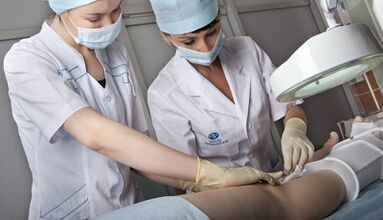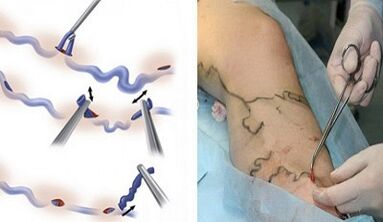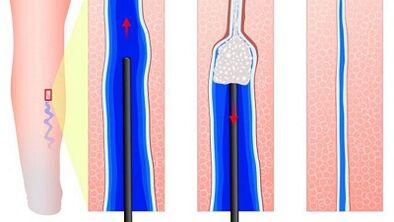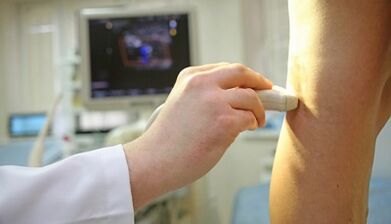Varicose veins are a specific disease of the vessels of the venous department, accompanied by incorrect valve operation and impaired blood flow.From Latin "varicose veins" can be translated as "bloating", which is completely corresponding to the visual picture of the disease.The work of varicose veins of the lower limbs is the most common and effective method of treatment.
When conservative treatment does not help

The treatment of varicose veins provides several options.Conservative therapy is prescribed in the initial stages, but sometimes even during this period they can prescribe surgery.
The reasons for surgery are the following:
- Physiological pathology - of course the development of varicose veins is not provoked by a secondary factor, namely the characteristics of the body or heredity;
- The extreme stages of varicose veins when conservative medicine is already powerless;
- The presence of trophic ulcer of the lower limbs;
- Disturbance of the blood circulation of the vessels of the lower limbs, directly affecting the general condition of the patient;
- Sudden blocking of blood vessels (thrombophlebitis).
Contraindications
Despite the ineffectiveness of conservative therapy, operations are not used in all situations.
Contraindications to varicose veins:
- constant increase in blood pressure or tendency to this disease;
- severe infectious pathologies;
- severe heart disease (recently suffered myocardial heart attacks, coronary disease);
- age exceeding seventy years;
- Dermatological diseases of the inflammatory nature - eczema, psoriasis;
- Pregnancy (second half of the term).
In each case, the phlebologist independently evaluates the patient's condition and decides on the appointment of a type of varicose surgery.
Types of Vienna
Surgical treatment of varicose veins of the lower limbs provides several ways to affect the focus of the problem.
Flbectomy

The most common type of surgical intervention, which provides the removal of varicose veins surgically.
This method involves the application of a small incision to the skin in the field of varicose enlargement.The affected area of the vein is then completely removed.
In this way, the removal of veins on the legs lasts for about an hour, the patient is discarded from the hospital for one to two days.The effectiveness of the method reaches a sufficiently high percentage, but with a discrepancy with the doctor's prescription, serious complications are possible.
MiniFo -Bectomy
Miniflebectomy is a method of treating varicose veins, suggesting punctures of the skin in the area of the lesion instead of cutting.The surgery is performed under local anesthesia at a day hospital.This means that after the end of the medical manipulations, the patient goes home almost immediately.
Advantages of Mini -Furectomy:
- lack of need for general anesthesia;
- outpatient conditions;
- Minimum number of contraindications;
- minimal skin injuries;
- Lack of rehabilitation period.
Miniflebectomy for varicose veins is often used as an auxiliary method or used in combination with other types of operations.
Sclerotherapy
Sclerosis of the veins of the legs - determining an enlarged area with the help of ultrasound.Then a special solution is introduced into the affected vein, which adheres to varicose veins, preventing blood flow.Due to the work, the blood supply to the lower limbs is restored and the trophic ulcers gradually heal.
There are 2 methods of sclerotherapy:

- Echosklerotherapy- The operation is used for the diameter of the varicose vein by more than one centimeter.This method is based on the study of the problem area and the subsequent entry of a special substance.It narrows the lumen of the vessel, restoring the blood.
- The use of foam- The most conventional and effective type of surgery that ensures the introduction of a special foaming substance into a varicose vein.The lumen of the vessel completely overlaps, rescuing the patient from pathological manifestations.
Sclerotherapy for varicose veins is used in complex form.
Removing vein with laser
Removal of varicose veins with laser is the most modern, technological and safe method of impact on varicose areas.The principle of surgery is based on the piercing of the skin in the field of varicose veins lesions and the introduction of laser light inward.The beam dissolves the area of the enlarged vein without consequences for the patient's body.
Laser coagulation is a type of laser surgery whose action leads to soldering varicose veins, blocking the blood.
Rh
RFA of lower limbs veins - radio frequency monitoring.The principle of surgery is based on the drilling of the skin area with the subsequent introduction of the ultrasound sensor.It emits special microwaves that affect varicose veins, leading to their coagulation.The positive side of the operation is the ability to dosage waves, thus regulating the process of vein bonding.
Preparation
Surgical treatment of varicose veins, regardless of the method, is a sufficiently serious manipulation that provides an extensive preparatory phase:

- Inspection and consultations from the surgeon.
- Ultrasound for varicose veins is a mandatory diagnostic method that allows you to determine varicose areas.
- General blood and urine test.
- Biochemical blood test.
- Blood coagulation indicators.
- ECG.
- X's chest.
- Blood pressure control.
On the eve of the surgery, it is necessary to limit yourself to a light meal and to appear in a medical institution on an empty stomach in the morning.In order for anesthesia not to harm the body, it is necessary to provide information about allergies and possible medicines to which such a reaction may occur in advance.
Postoperative period
The postoperative period after the removal of varicose veins of the legs flows smoothly and in most cases without complications.Specific recommendations depend on the type of operation.For example, if after phlebectomy, the patient needs 2-3 days to recover, then after removing the laser of varicose veins, he or she returns home on the day of surgery.
Those patients who need sick leave, the document is issued for a period that provides for the ability to work depending on the type of activity.If the profession is not related to physical exertion and long-term finding a person on the feet during the day, sick leave is issued for a period of 5-7 days.Otherwise, a certificate of inability to work may be up to 2-3 weeks.In each case, the doctor decides on the basis of the postoperative indicators.
Registration prevention
The surgery for the treatment of varicose veins provides a set of preventive measures:
- The first days after the surgery to remove varicose veins, you must use elastic bandages in the area of puncture or incisions;
- Use linen - socks, golf;
- After the surgery, limit the increase of all weights and within six months - in a volume of not more than 10 kg;
- Limit sports to small tracks, walks, swimming;
- Follow excess weight;
- Over time, subjected to drug therapy courses aimed at restoring the tone of the veins and the exclusion of varicose veins;
- Timely examinations with the doctor;
- Reducing the use of coffee and tea;
- Make your feet gymnastics;
- Use free shoes;
- More often, be in the fresh air and lead a healthy lifestyle.
In the first days after surgery to remove varicose veins, it is necessary to exclude the use of hot baths, heavy exercise, including driving a car, and to limit smoking and drinking alcoholic beverages.
The cost of surgery
The cost of varicose veins depends on many nuances.This includes both the doctor's study and the complex of additional examinations that cannot be distributed.
As a rule, when the exam is suffered at the same clinic where the operation is planned, the cost of services will be lower if the manipulations are performed in different places.
Asking which operation is more efficient, in this case you can safely focus on prices.Despite the fact that laser removal of varicose veins is the most expensive method, it is the most effective, painless and does not provide recurrence.
